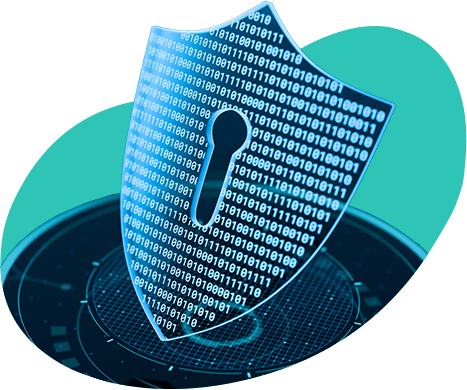Rethink, Revamp & Rule Cybersecurity Lead Generation

- Differentiate to Dominate: Clearly articulate unique differentiators with quantifiable proof points to capture attention in the crowded cybersecurity market and attract high-quality leads.
- Persona-Driven Content: Effective B2B lead generation in the cybersecurity industry demands detailed buyer personas and tailored messaging to convert potential leads into customers.
- Self-Service Buyer Journey: Invest in chatbots, interactive demos, and ROI calculators that provide potential customers valuable insights and help them independently evaluate cybersecurity solutions.
- Transparency Builds Trust: Case studies, client testimonials, third-party validation, and data-backed reports strengthen your brand’s authority in the eyes of prospects.
- Strategic Personalization: Deliver customized content experiences by leveraging website visitor identification tech, behavioral insights, advanced segmentation, and AI-driven strategies.
- Marketing & Sales Alignment: Defined KPIs, formal SLAs, and integrated CRM platforms streamline the conversion of leads into customers by shortening sales cycles and improving lead quality.
- Quality Over Quantity: Deploy account-based marketing (ABM) strategies, including precise targeting, customized outreach, and personalized content, to engage ideal customers directly.
- Analytics & Optimization: Use analytics tools such as GA4, Adobe Analytics, GSC, Mouseflow, Hotjar, ContentSquare, etc. to identify key insights for converting more leads.
Cybersecurity is booming, growing from $152.71 billion in 2018 to an estimated $202.98 billion in 2025. Despite this rapid expansion, cybersecurity marketers still struggle significantly with generating high-quality leads in a crowded market.
Strategies that were effective just a few years ago no longer resonate with today’s cybersecurity buyers. Now, potential customers thoroughly research solutions online, prioritize peer reviews, and independently verify vendor claims. Often, they delay direct sales interaction until late in their buying process, making traditional outreach ineffective.
Tom Shapiro, author of Rethink Lead Generation and CEO & founder of Stratabeat, stresses the importance of innovative, strategic approaches to engage modern buyers effectively. In today’s highly crowded market, cybersecurity companies must clearly articulate their unique value and demonstrate expertise that directly addresses evolving cyber threats.
If your cybersecurity firm struggles to consistently convert potential leads into SQLs and loyal, long-term customers, use this guide as your blueprint. You’ll discover practical, effective strategies to transform your approach to cybersecurity B2B lead generation.
Key Challenges for CMOs and Marketing Teams
Demand for Transparency and Authenticity
Given cybersecurity’s inherent risks, buyers value authenticity, transparency, and proven results over promotional rhetoric. Invest in verified case studies, credible customer testimonials, third-party validations, and comprehensive data-backed reports to establish your credibility and trustworthiness.
Budget and ROI Pressures
With rising acquisition costs and increasingly complex B2B customer journeys, proving marketing ROI is critical. Optimize budget allocation by:
- Implementing sophisticated attribution tools that measure campaign effectiveness accurately.
- Continuously reallocating resources toward high-performing channels and campaigns, such as targeted ABM and personalized outreach.
Demonstrable ROI transforms marketing investments into predictable revenue growth.
Common Mistakes Sabotaging Your Lead Generation
How to Rethink and Revamp Your Cybersecurity Lead Generation Strategy
Transform Your Website into a Conversion Engine
Your B2B website must serve as your primary platform for attracting, engaging, and converting potential clients within the cybersecurity industry. Tom Shapiro emphasizes that ineffective CTAs are among the most common yet solvable reasons cybersecurity companies fail to convert visitors into qualified leads.
Follow these strategic best practices to significantly increase conversions and SQLs:
- Analyze and Overhaul Ineffective CTAs: Regularly conduct behavioral analyses using CRO software to track clicks on each CTA type. If CTAs such as “Contact Us” or “Contact Sales” attract minimal or zero engagement, replace them immediately. Don’t waste valuable real estate with CTAs that aren’t performing.
- Contextual Relevance Matters: Tailor CTAs to match user intent and content context. Use “Book a Demo” for product-focused pages, and educational resources like reports or webinars on top-of-funnel (TOFU) content. Contextually relevant CTAs significantly improve engagement and conversion rates.
- Cascade Your CTAs in Blog Posts: Instead of repeating a single CTA multiple times (or worse, only including a single CTA at the bottom), adopt a cascading approach. Introduce informational CTAs early, then shift to more action-oriented offers—such as templates, white papers, case studies, or assessments—as visitors move deeper into your posts.
- Diversify CTA Formats Visually: Disrupt visual patterns to attract attention. Experiment with different CTA formats like floating bars, pop-ups, and slide-ins to maximize visitor engagement.
- Use Clear, Action-Oriented Language: Generic CTAs are usually ineffective. Clearly state the value of each offer with actionable language like “Download Your Free Cybersecurity Report,” “Access the Threat Assessment Template,” or “Schedule a Cybersecurity Demo.”
- Promote Live Events Strategically: Leverage upcoming webinars or live online events by prominently featuring event-focused CTAs throughout your website. This overlooked tactic often delivers high engagement and conversions, helping you grow your database of companies and potential clients.
- Continuous A/B Testing and Optimization: Never “set and forget” your CTAs. Rigorously test different messaging, design elements, and placements through continuous A/B testing. This ensures ongoing optimization, producing consistently improved performance from your cybersecurity lead generation campaigns over time.
- Simplify Lead Capture Forms: Short, intuitive forms reduce friction, making it easier for ideal clients to engage and convert.
By systematically implementing these CTA best practices, you’ll transform your website into a reliable, high-performance conversion engine, significantly enhancing your cybersecurity marketing ROI and consistently attracting qualified, high-quality leads.
The Role of SEO and Content Marketing in Lead Generation
In the competitive cybersecurity landscape, strategic SEO and content marketing are essential for standing out to your ideal customer profile. Tom Shapiro emphasizes the importance of differentiation to avoid becoming lost in a crowded, competitive landscape.
SEO: Building Visibility from the Ground Up
Effective SEO creates a sustainable foundation for reaching cybersecurity decision-makers. Key strategies include:
- Technical Excellence: Optimize your website performance, responsiveness, and page load speeds to engage high-intent visitors from targeted technology companies.
- Voice and Conversational Search Optimization: Capture leads researching cybersecurity solutions via voice assistants by structuring content around conversational queries related to your cybersecurity products and solutions.
- Intent-Driven Keywords: Precisely map keywords to buyer intent, attracting traffic that closely matches your ideal customer profile.
Content Marketing: Establishing Trust and Authority
Cybersecurity decision-makers value authentic expertise. Content marketing effectively addresses skepticism, providing clear and practical guidance:
- Practical, Educational Content: Create targeted blogs, whitepapers, and guides addressing pressing cybersecurity challenges and highlighting your unique cybersecurity services.
- Interactive Webinars and Workshops: Offer engaging, real-time sessions delivering actionable insights to your audience of potential clients.
- Dynamic Content Journeys: Use marketing automation to deliver personalized experiences aligned to buyer roles and interests, moving your prospects effectively through their journey.
Integrated Channel Execution
Maximize your SEO and content marketing by integrating across multiple channels:
- Consistent Messaging: Ensure uniform branding across SEO content, email marketing, social media platforms, and retargeting, reinforcing trust and clarity.
- Strategic Distribution: Distribute valuable content through targeted LinkedIn posts, personalized emails, and carefully crafted retargeting campaigns focused on your key database of companies.
Data-Driven Optimization for Ongoing Improvement
Optimize your cybersecurity marketing by continuously refining your SEO and content marketing efforts through:
- Real-Time Analytics Dashboards: Track content performance, engagement, and conversions from your cybersecurity marketing campaigns over time.
- Conversion and Attribution Tracking: Measure which content initiatives generate qualified leads and revenue, guiding ongoing optimization efforts.
At Stratabeat, our customized dashboards deliver actionable insights, demonstrating marketing performance to drive continuous improvement and enhance overall return on investment.
Effective ABM Strategies for High-Quality Cybersecurity Leads
Within the cybersecurity sector, Account-Based Marketing (ABM) allows marketers to precisely target ideal customer profiles, focusing on accounts that offer substantial revenue potential:
- Identify Ideal Target Accounts: Leverage criteria such as company size, alignment with your cybersecurity solutions, and strategic value to develop a targeted database of companies.
- Personalized Content and Messaging: Craft customized campaigns explicitly addressing the cybersecurity pain points, priorities, and business objectives of your target accounts.
- Deploy Targeted Outreach: Utilize powerful tools like LinkedIn Sales Navigator or ZoomInfo to deliver specific ads, personalized email campaigns, and dedicated landing pages tailored precisely to your highest-potential cybersecurity prospects.
Technology companies employing strategic ABM consistently report shorter sales cycles, improved lead conversion, and increased return on investment.
Accelerating Growth through Referrals and Strategic Partnerships
Strategic partnerships and referrals significantly boost your cybersecurity business’s visibility, credibility, and reach. Leverage these strategies to attract more high-value potential clients:
- Strategic Collaborations: Develop formal partnerships with Managed Service Providers (MSPs), cybersecurity venture and advisory firms, and complementary companies in the technology sector to extend your access to new competitive markets and amplify your market authority.
- Customer Referral Programs: Create structured programs rewarding satisfied cybersecurity clients who advocate your products and services, driving qualified leads into your pipeline.
Referrals and strategic partnerships are proven methods for generating high-quality leads, improving your overall cybersecurity market penetration, and enhancing long-term return on investment.
Measurement & Analytics: Tools for Actionable Insights
Measuring marketing effectiveness is crucial for justifying and optimizing your cybersecurity lead generation investments. Use analytics tools to track and refine your approach:
- Google Analytics 4 (GA4): Real-time analytics with predictive features, identifying successful content and channels attracting your ideal customer base.
- Adobe Analytics: Comprehensive insights into user behavior, campaign engagement, and overall performance across your lead-generation initiatives.
- Google Search Console (GSC): Organic search analytics that helps you to monitor, maintain, and troubleshoot your website’s presence in Google search results.
- Mouseflow: Behavioral analytics and video recordings of user website sessions to enable you to identify key behavioral insights along with any friction that’s being caused by your site.
Deploying these tools ensures cybersecurity marketers confidently allocate budgets toward activities that deliver measurable returns, driving sustained growth and profitability.





